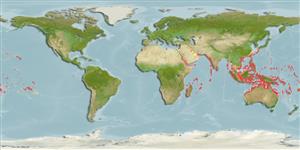Common names from other countries
>
Eupercaria/misc (Various families in series Eupercaria) >
Labridae (Wrasses) > Cheilininae
Etymology: Pseudocheilinus: Greek, pseudes = false + Greek, cheilos = lip (Ref. 45335).
More on author: Bleeker.
Environment: milieu / climate zone / depth range / distribution range
Ecologia
marinhas associadas(os) a recifes; intervalo de profundidade 1 - 35 m (Ref. 90102), usually 4 - 35 m (Ref. 27115). Tropical; 24°C - 28°C (Ref. 27115); 32°N - 36°S, 24°E - 136°W
Indo-Pacific: Red Sea south to Natal, South Africa (Ref. 4392) and east to the Tuamoto Islands, north to the Ryukyu Islands, south to Lord Howe and the Austral islands. Distribution includes St. Brandon's Shoals and Gulf of Tadjoura (Ref. 33410).
Tamanho / Peso / Idade
Maturity: Lm ? range ? - ? cm
Max length : 10.0 cm TL macho/indeterminado; (Ref. 4392)
Descrição breve
Chaves de identificação | Morfologia | Morfometria
Espinhos dorsais (total) : 9; Raios dorsais moles (total) : 11 - 12; Espinhos anais: 3; Raios anais moles: 9. Identified by the brightly color lined pattern and the small ocellus on the caudal fin base (Ref. 48636).
Occurs in seaward reefs among coral branches. Also in clear coastal waters, dense coral habitats on shallow reef crest or slopes to depth of about 20 m. Usually occurs in small loose groups. A shy species, usually swimming amongst the protection of coral branches (Ref. 48636). Feeds mainly on small crustaceans (Ref. 1602). Secretive (Ref. 37816).
Life cycle and mating behavior
Maturities | Reprodução | Spawnings | Egg(s) | Fecundities | Larvas
Oviparous, distinct pairing during breeding (Ref. 205).
Randall, J.E., 1999. Revision of the Indo-Pacific labrid fishes of the genus Pseudocheilinus, with descriptions of three new species. Indo-Pac. Fish. (28):34 p. (Ref. 33410)
Categoria na Lista Vermelha da IUCN (Ref. 130435)
CITES (Ref. 128078)
Not Evaluated
Ameaça para o homem
Harmless
Utilização humana
Pescarias: espécies comerciais; Aquário: Espécies comerciais
Ferramentas
Relatórios especiais
Descarregue XML
Fontes da internet
Estimates based on models
Preferred temperature (Ref.
115969): 24.5 - 29, mean 27.8 (based on 1264 cells).
Phylogenetic diversity index (Ref.
82804): PD
50 = 0.5078 [Uniqueness, from 0.5 = low to 2.0 = high].
Bayesian length-weight: a=0.01549 (0.00726 - 0.03306), b=2.96 (2.78 - 3.14), in cm Total Length, based on LWR estimates for this species & (Sub)family-body (Ref.
93245).
Nível Trófico (Ref.
69278): 3.2 ±0.0 se; based on diet studies.
Resiliência (Ref.
120179): Elevada, tempo mínimo de duplicação da população menor que 15 meses (Preliminary K or Fecundity.).
Fishing Vulnerability (Ref.
59153): Low vulnerability (10 of 100).
